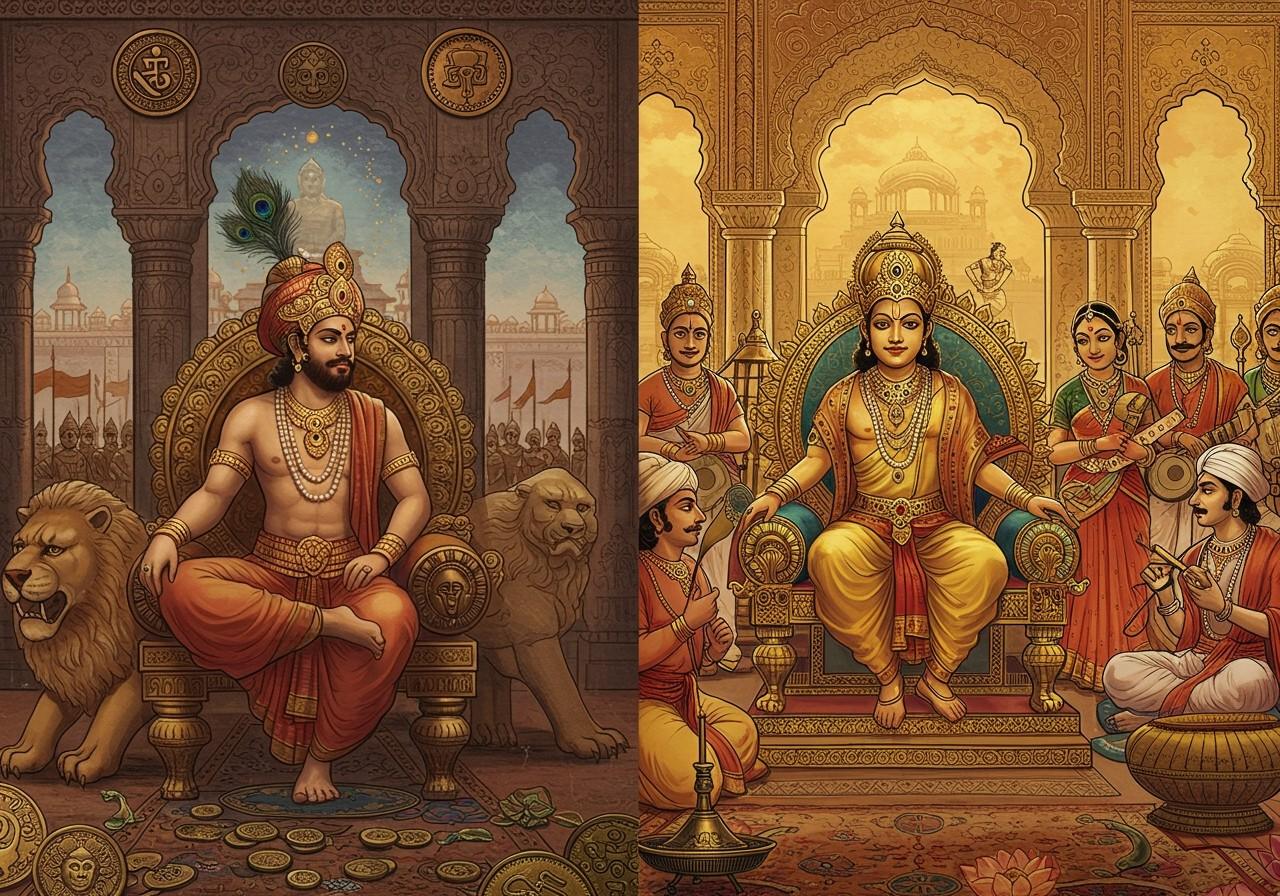
The Gupta and Maurya Dynasties stand as pillars of ancient Indian history. Each left an indelible mark on the cultural, political, and social fabric of the subcontinent. While the Mauryas (325-185 BCE), under Chandragupta Maurya, forged a unified India with a centralized administration, the Guptas (320-550 CE), founded by Sri Chandragupta, ushered in a “Golden Age” of cultural flourishing, driven by agrarian reforms and a revival of trade.
Political Structures: Centralization vs. Decentralization
The Mauryan Empire, particularly under Chandragupta Maurya and his advisor Chanakya, implemented a highly centralized administration. The Arthashastra served as a comprehensive guide to statecraft, outlining political and economic policies. Emperor Ashoka’s reign witnessed a shift towards benevolent rule and the widespread propagation of Buddhism.
In contrast, the Gupta Empire embraced decentralization. Rulers like Chandragupta I and Samudragupta empowered local governance. Administrative innovations, such as land grants to officials, further solidified regional control.
Economic Policies: Trade and Agriculture
Both empires thrived on robust trade networks. The Mauryans established connections with Hellenistic kingdoms and Southeast Asia, implementing state-controlled enterprises and standardized measures. The Guptas, meanwhile, saw flourishing trade with the Roman Empire and Southeast Asia. Agriculture formed the backbone of their economy, with guilds playing a crucial role in trade and industry.
Cultural Achievements: Buddhism and Hinduism
The Mauryan era witnessed the rise of Buddhist art and architecture. Stupas and pillars inscribed with Ashoka’s edicts became prominent features of the landscape. Buddhism flourished under Mauryan patronage, spreading its influence across Southeast Asia. The Guptas, conversely, championed Hinduism. This led to a renaissance in literature, science, and the arts. Literary giants like Kalidasa and scientific luminaries like Aryabhata made groundbreaking contributions. Architectural marvels like the Udayagiri temples stand as testaments to Gupta artistic achievements.
Military Prowess: Conquest vs. Consolidation
The Mauryan Empire maintained a formidable military, complete with war elephants and cavalry. Chandragupta Maurya’s conquests and Ashoka’s transformative Kalinga War are key events in Mauryan military history. The Gupta Empire, while possessing military strength, prioritized consolidation over expansion. Strategic alliances and diplomatic marriages played a key role in maintaining power and stability.
Social Structures: Egalitarianism and the Varna System
Ashoka’s reign saw a push towards a more egalitarian society, influenced by Buddhist principles. The Gupta period, in contrast, witnessed a resurgence of the varna system and Brahmanical traditions. The social status of women and opportunities for social mobility varied significantly between the two eras.
Poojn.in: Connecting You to India’s Rich Heritage
At Poojn.in, we recognize the profound connection between India’s history and spiritual traditions. As you delve into the fascinating history of the Gupta and Maurya Dynasties, explore our collection of authentic puja items, many of which have roots in these ancient eras.
- Pure copper and brass items: Discover handcrafted items reminiscent of those used in ancient temples, adding a touch of historical authenticity to your puja rituals. These pieces serve as a tangible link to the rich metalworking traditions of the past, allowing you to incorporate history into your spiritual practice.
- Traditional dhoop and agarbatti: Enhance your spiritual atmosphere with traditional incense, similar to those used in ancient ceremonies. These fragrances create a sacred ambiance, evoking the spiritual practices of bygone eras.
- Authentic rudraksha malas and spiritual jewelry: Adorn yourself with authentic rudraksha malas and spiritual jewelry, connecting with ancient traditions of self-adornment and spiritual practice. These pieces offer a blend of aesthetic beauty and spiritual significance.
- Pure cotton wicks and ghee for diya lighting: Illuminate your puja space with pure cotton wicks and ghee, just as it was done in ancient times. These traditional materials enhance the purity and sanctity of your diya lighting rituals.
- Sacred texts and religious books: Deepen your understanding of Indian history and culture with our selection of sacred texts and religious books. These resources provide valuable insights into the philosophical and spiritual foundations of these historical periods.
Visit www.poojn.in to explore our complete collection of traditional puja items and connect with India’s rich heritage. Our products are carefully chosen for authenticity and ritual purity, reflecting the reverence of the Gupta and Maurya periods.
Maa Saraswati Murti
Radha Krishna Pariwar Bigraha
Conclusion
The Maurya and Gupta Dynasties shaped the course of Indian history. The Mauryas unified much of the subcontinent and propagated Buddhism, while the Guptas fostered a golden age of cultural and intellectual achievements. Understanding these two pivotal empires provides invaluable insights into the rich tapestry of Indian civilization.


